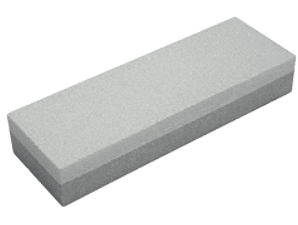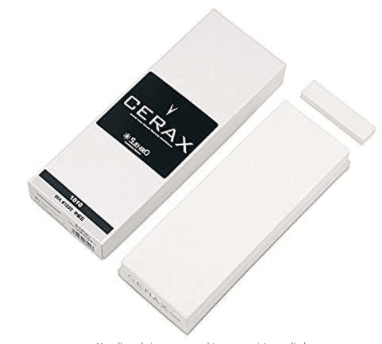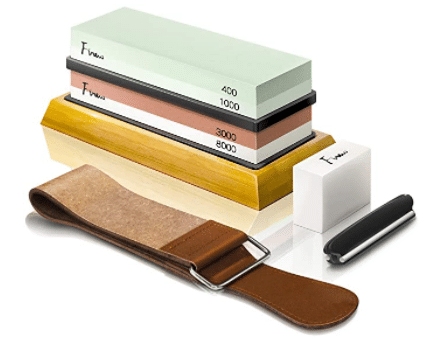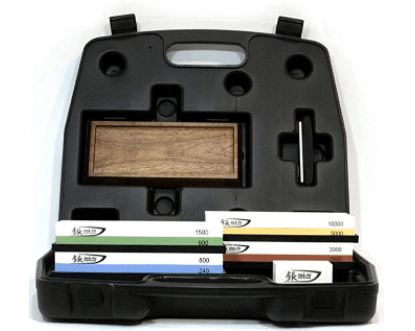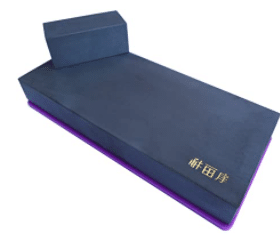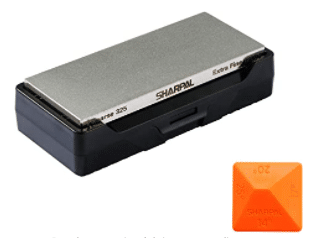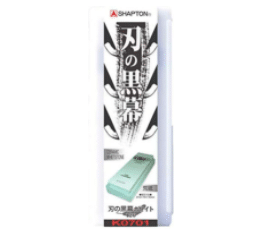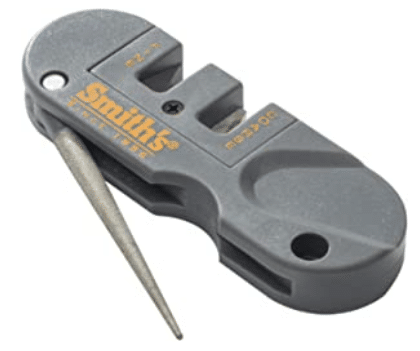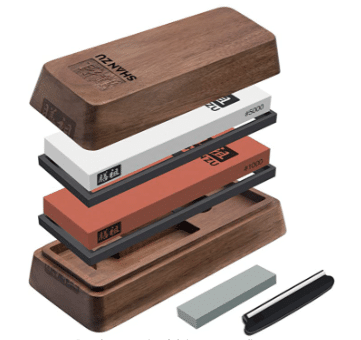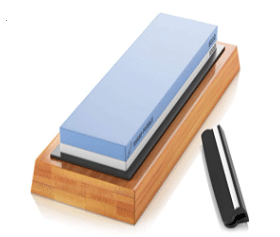Introduction
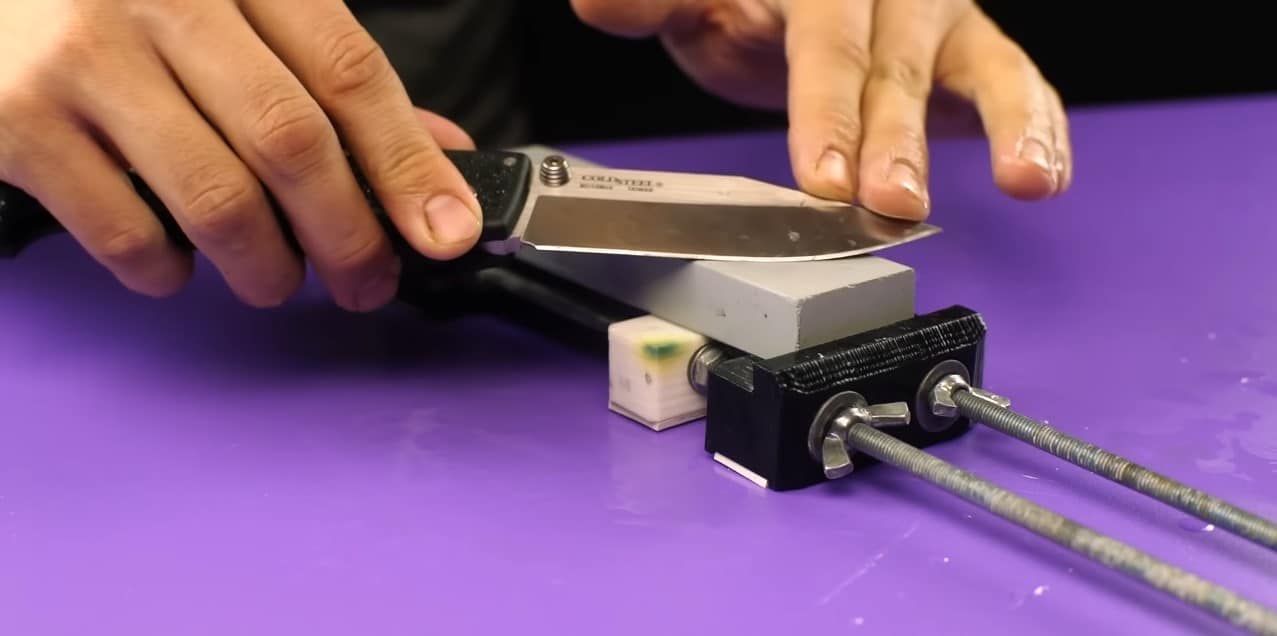
Usage of dull knives is dangerous for everyone because of the high probability of injuring fingers or other parts of the body. It happens because you put more effort into cutting anything with a dull blade, and it makes the knife slip and hurt your hand or, even worse, fall and break something. That is why you should pay attention and check the blade of the knife before using it.
Then, when it is not sharp enough for cutting products without extra effort, it is time to sharpen it.
Top 10 Best Sharpening Stones
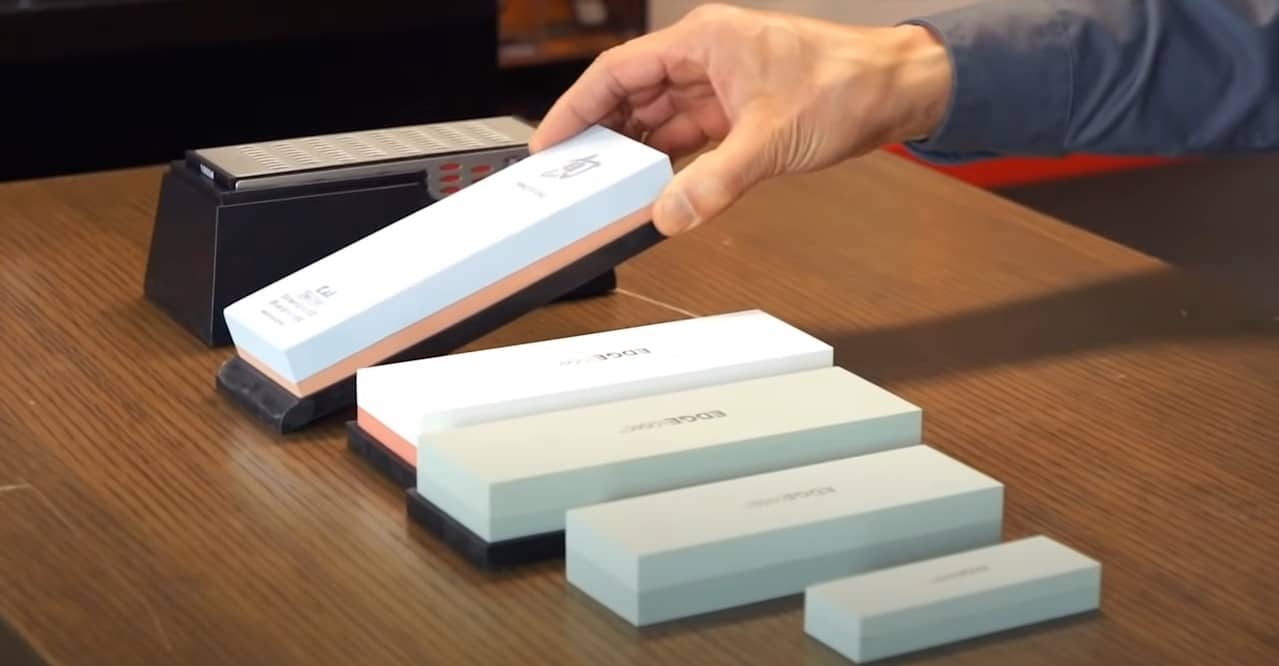
1 — Bora 501057 Sharpening Stone with Coarse/Fine Combination
This sharpening stone produced by Bora requires oil or water to work with because it is made of a synthetic material — aluminum oxide. The grit level of this water stone is suitable for sharpening almost every type of blade, be it a knife, ax, or chisel. The size of its surface allows you to work on the table and do not worry about the comfort of the procedure. It is two inches long, six inches wide, and one inch thick, and this is a universal size for regular sharpening.
The rougher surface of the stone has a 150-grit level, and you can use it for the sharpening of dull blades. After this, you can turn the stone to another side with a 240-grit level and finish sharpening with the creation of a precise and razor-sharp edge.
The price of this sharpening stone is affordable for routine maintenance of the sharp edges and is cheaper than other stones and sharpeners. If you are interested in getting a whetstone for yourself, here is a good, cheap stone for sharpening blades.
Check this website and read more about the characteristics of the Bora sharpening stone and its price.
2 — Suehiro CERAX Soaking Whetstone
It is a ceramic sharpening stone that is convenient to use even for people without experience in sharpening knives. Silicone attachment allows to set the stone on the table and sharpen blades without any probability of getting injuries. The size of the Suehiro stone is three inches wide, eight inches long, and one inch thick that is similar to common parameters of sharpening stones. It means that you can make an edge of almost any blade sharp with this stone.
You can select the grit level of the stone based on your needs as the producer provides a variety of stones with maximum grit equal to 8,000 and a minimum one equal to 320. This stone will serve you for a long time because it is made of high-quality, durable ceramic. Moreover, you will receive a special Nagura flattening stone and apply it for the care of the main sharpening stone.
You can find the price and detailed description of the Suehiro sharpening stone here.
3 — Finew Knife Sharpening Stone Kit
By buying this sharpening kit, you will have all the necessary tools for knives sharpening and maintenance of the stones. The main advantage of such an investment is that this kit includes two types of stones for both purposes: sharpening dull blades and refining the metal things. These stones have two sides with different grit levels, and it makes the tool universal. If you want to create a razor-sharp edge on your dull knives, you can use the stone with sides of 400 and 1,100 grit, but when you want to polish your cutlery, you should apply 3,000 and 8,000 sides of another stone.
Furthermore, you do not need to worry about the correctness of chosen sharpening angle with this kit. The brand attached an angle guide to this kit, which makes sharpening easier and safer for users. By the way, do not be surprised by the leather strap included in the kit. It is an instrument for burrs removing, and finishing sharpening after usage of stones.
Producers did not forget to provide another small flattening stone for shaping main stones and a special bamboo holder for the basement of the stone. All these details will transform the sharpening of knives into an enjoyable operation for you and prevent any possible damages.
Do not lose an opportunity to have a professional knife sharpening kit in your kitchen, and order it here.
4 — ShaPu Whetstones Premium Knife Sharpening Set
This ShaPu sharpening kit includes even more advanced tools for the sharpening process because here, you can find four sharpening stones and all the supportive instruments you need. Four sharpening stones added into the kit have two different grit levels on their sides. It means that you will receive stones with eight sharpening sides with minimum grittiness equal to 240 and the maximum one — 10,000.
Besides, all the sharpening stones in this set are the same — 2.25 inches wide and 7.25 inches long. You can be sure that the area of the stones’ surface is enough for working any kind of blade.
In addition to the stones, you will get a wood mount with a silicone “shoe,” a flattening stone, a guide for knife angle, and a case for storing the set.
Check the market price for this good here and supply your family with an advanced ShaPu set for the sharpening process.
5 — Masuta Natural Sharpening Honing Stone
Masuta stone is a specific tool for knife sharpening because it has such characteristics as high solidity and grit. The reason for these unique features is their natural origin. You can notice it from a unique color of the stone — “ocean blue.” This sharpening stone is made from natural materials extracted in Japanese underwater caves. Masuta natural stones sharpen knives or other blades to extremely sharp edges because of the high grit level — 12,000.
This sharpening stone has a typical size — 3.5 inches wide and 8 inches long. Coming with a non-slip pad, Masuta stone is secure to use even for beginners in sharpening. Moreover, these natural stones come with a case and additional Nagura stone what allows you to save the high performance of the stone for a long time.
The price and characteristics of the Masuta Natural Stone are described here.
6 — SHARPAL 156N Diamond Whetstone Sharpener
As we have already said, diamond sharpening stones do their work faster and more precisely because of the natural material. This stone from SHARPAL consists of a steel base and an electroplated to metal plate diamond surface. The construction is suitable for sharpening dull edges with the 325-grit level side and for fine edges with the 1,200-grit level side.
One of the advantages of diamond stones is that you do not need to use oil or water during the sharpening process. It can sharpen ceramic, steel, cubic boron nitride, and carbide blades without additional help.
Purchasing this good, you will receive 2.5 inches wide and 6 inches long stone, a non-slip case that can be applied as the base and knife guide for sharpening.
Learn the current price for this stone here.
7 — Shaptonstone Traditional Homogenous Waterstones
Kit from Shaptonstone is a set of several Japanese ceramic stones different by their grittiness that ranges from 120 to 30,000. That is why you will always be able to sharpen your knife independently from the original conditions. All of the included stones have the same size — 1.65 inches thick, 9 inches long, and 3.5 inches wide. This surface is enough for common-sized knives and some other blades.
Furthermore, you can use a plastic base from the kit to locate the stone stably on the table and do not injure yourself. Do not forget to soak the sharpening stone with water before usage.
Get more information about this product on this website.
8 — Smith’s Hunting Knife Sharpener
If you are searching for a portable sharpener that can be used in survival conditions, Smith’s Abrasives PP1 sharpener is the best option for you. It is an elaborated tool that has two slots for sharpening with different coarse. You should select the proper one according to the state of your blade. Moreover, it has a set angle for moving the knife inside the slot. It means that you cannot make any mistake while choosing an angle for sharpening.
Additionally, a rod with a diamond surface is attached to the sharpener. You can easily apply it for the sharpening of serrated blades or pocket knives, and be sure that it will create a razor-sharp edge.
There is no other competitor for this sharpener, and it can become the best investment in your camping gear. Click here to learn the price for the portable sharpener and order it.
9 — SHAN ZU Whetstone Knife Sharpening Set
Searching for an aesthetic addition to your kitchen interior, you can buy a set of sharpening stones provided in a bamboo case. This kit from Shan Zu consists of two sharpening stones with different levels of grit (1,000 and 5,000), a wood box that can be used as a supportive base for the sharpening, and an angle guide.
It is a perfect setting for regular knife sharpening as it includes both types of stones — one for completely dull knives and one for finishing and polishing blades. Moreover, the content of this sharpening set allows producing a fine edge without any effort because of the preset right angle and the non-slip surface of the base.
You can find information about the price of this product here and add a good quality sharpening set to your kitchen right now.
10 — Sharp Pebble Premium Whetstone Knife Sharpening Stone
This is the best sharpening stone offered by reliable brands because of its practical and attractive design. Framed into a bamboo base, this sharpening stone has two sides with different grit levels. A bigger 1,000-grit side is perfect for processing the dull edge of kitchen knives or other blades, and another 6,000-grit one allows creating fine edges. The length of the stone equals 7.25 inches, while the width is equal to 2.25 inches.
Ordering this product, you will receive an aluminum oxide sharpening stone, a handy angle guide, and a bamboo case. Increase the quality of your edge tools in the kitchen with this affordable sharpening stone.
Click here and check the current price for Sharp Pebble Whetstone.
The fastest way to learn
Learning how to sharpen a survival knife is something that can only come with experience, just like any survival skill. You could read a million “how-to” guides and articles on the best way to sharpen a knife and still not be able to do it.
It has been said that knife sharpening is the hardest of knife care tasks, and that’s probably true because it does take some practice to get it right. Therefore, the first step is to pick up a knife and a stone or other sharpening device and begin. Learn how to sharpen a scandi grind on your knife. As the old saying goes, “A journey of a thousand miles begins with the first step.”
We devoted this article to the process of knives sharpening with different types of stones. Also, we will review some of the best sharpening stones available on the market and provide recommendations for you to select the best sharpening stone for your blades and boost your knowledge of tricks and hacks for camping and survival.
Differences Between Types of Stones

1. Oil Stones
This type of sharpening stone is suitable for the creation of subtle edges on your knives and tools. Usually, it is made of silicon carbide, novaculite, or aluminum oxide and requires oil to remove small pieces of metal. Oil stones vary by their level of coarseness, and you should select them based on your purposes.
The main advantages of these synthetic stones are their long lifetime and unnecessary alignment. So, you do not need to maintain the state of the oil stone because it is solid enough to keep its shape and perform its functions for a long time.
However, there are some drawbacks to the usage of oil stones. Firstly, the process of edge sharpening with oil stone takes more time than with other stones. Its cutting rate is low, and that is why you need to spend more energy and time sharpening with an oil stone.
Furthermore, you can use oil stones only with special sharpening oil. So, you will spend some extra money on the oil in addition to the stone itself.
2. Ceramic Stones
Ceramic sharpening stones are more expensive than other types of stones because of their reliability. You can easily create a fine edge on your blades with ceramic stone and do not worry about the stone’s quality for the next procedures. The grain size of ceramic stones is appropriate for almost all types of blades and saves its ability to sharpening for years.
3. Water Stones
Water stones are made of the same material as oil stones — aluminum oxide. However, instead of oil, you should use water to remove metal from the stone during sharpening. Moreover, water stones have a softer, sharpening surface, making the process easier and faster for you.
The main disadvantage of water stones is that they cannot keep the shape for several applications. You have to flatter your water stone after usage to use it efficiently next time.
4. Diamond Stones
Diamonds are common to use for sharpening any materials because of their solid structure. As regards diamond stones, it is a construction made of diamonds attached to a metal base. People use diamond stones for flattering other types of stones because of their durability. Of course, you have to pay moe for such a resistant material, and that is why diamond stones have the highest prices among all types of stones.
Diamond sharpening stones allow working with knives with teeth because some of the stones have a smooth surface. Also, you can sharpen blades much faster with diamond stones because of the characteristics described above.
You can find diamond stones with different types of surfaces nowadays based on your needs. Some of them have small holes to remove metal particles, and all of them have different levels of coarseness.
How to Choose Sharpening Stone
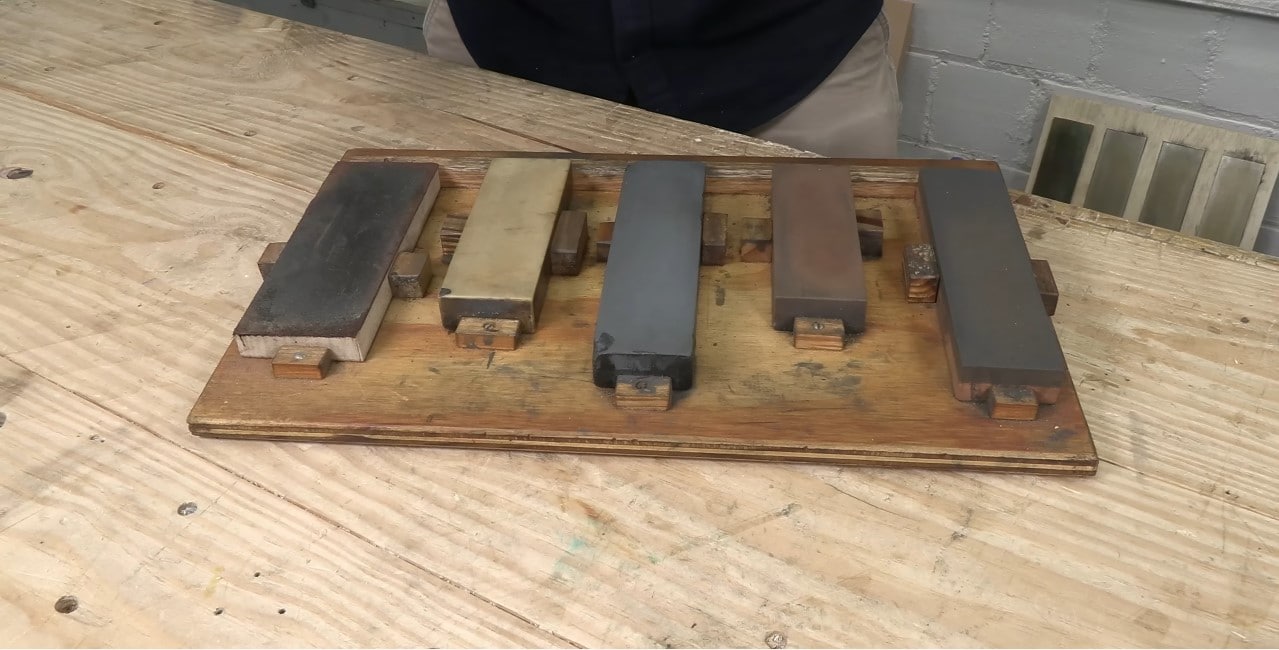
1 — Stone Size
There is a universal size of sharpening stones suitable for different blades — three inches wide, one inch thick, seven inches long. These parameters allow for sharpening all types of knives, from small to large ones. Make sure that the size of the stone surface is enough for sharpening your knives when choosing the stone.
2 — Stone Material
The material of the stone determines the level of sharpness and fineness of the blade. For instance, if you need to sharpen a knife for cutting soft materials in the future, it is better to apply diamond stones with a low level of grit. It will sharpen an edge to toothier form and allow you to slice things and not saw them.
On the other hand, when you need to use a knife with the hardest materials, we recommend you to use oil, water, or diamond stones with a high level of grit. They create thin edges that can cut materials without any effort.
Pay attention to the durability of different types of stones because it will determine the need to resurface the stone. As we have said earlier, softer types of stones require more often flattering than solid ones.
3 — Stone Grit
You should select the grit level of the stone based on the state of the knife. There is a special indicator that shows the grit size of the stone, and it varies from 100 to 3,000 approximately. Stones with a grit level of 100-400 are mostly suitable for dull blades and knives with burrs because they are harder. If you need to sharpen knives regularly, it is better to choose stones with grit levels from 700 to 2,000. When working with blades that are supposed to be extremely sharp and smooth, select the stone with a higher level of grit.
4 — Stone Design
Some sharpening stones are adopted for regular usage and have a convenient and safe design. This type of sharpening tool has slots with stone where you should locate the blade and move it forward and backward. Also, such stones have special coarse slits for more dull blades and fine slits to grind metal. However, they do not allow you to create precise thin edges because you cannot choose any other sharpening angle except from set one.
Another type of stone is harder to use, but it provides more ways for users to sharpen the blades. Usually, it is a construction made of stone and a non-slip surface for better attachment of the stone to the table or another supportive surface.
How to Sharpen Knife with Stone
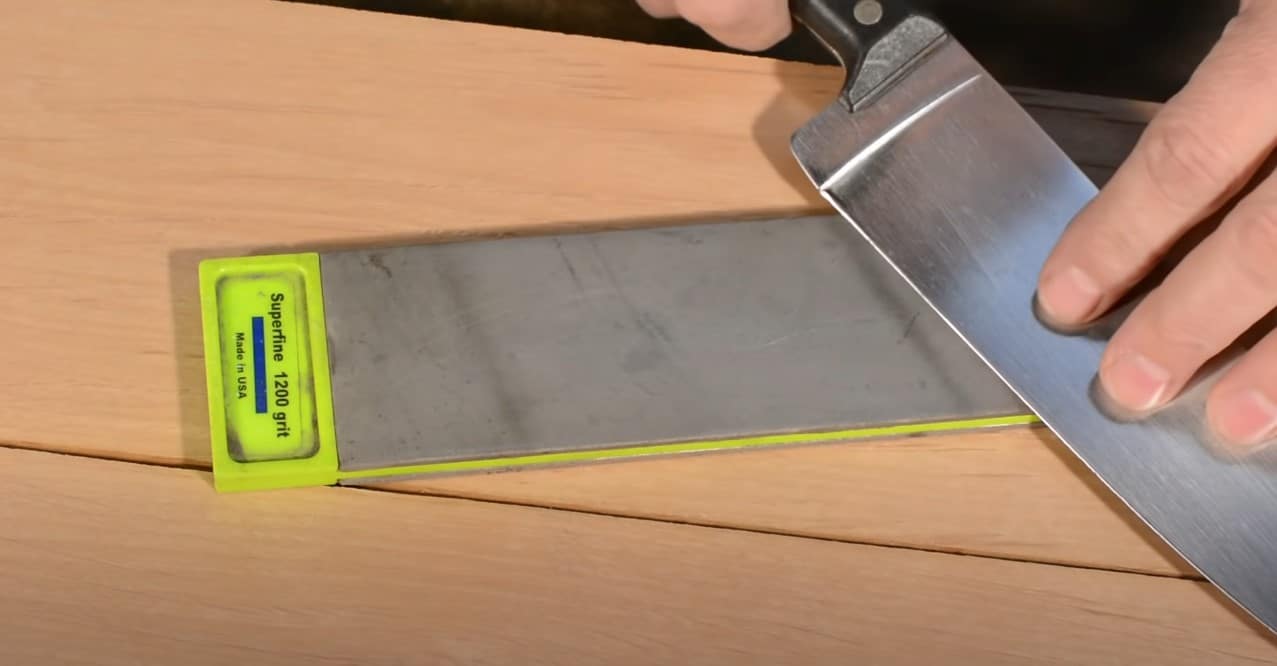
It’s also important to know that the coarse grade sharpening surface is meant to remove defects while restoring the edge, while the fine grade hones the edge to a sharp finish.
Always use the same direction for sharpening, whether you choose front-to-back or back-to-front. Make sure you’re using the whole surface of the stone, which will maintain consistency while sharpening.
Knife Sharpening Algorithm
Here is the basic process of sharpening any knife with a stone.
- Place the stone on a countertop so that the coarse grit is facing up. A wet paper towel underneath will keep it from sliding around on you.
- Hold the knife by the handle with the edge against the stone, point first, and make sure the edge of the knife rests against the stone at a 22-degree angle. Use your other hand to stabilize the blade.
- At this time, apply moderate pressure while you slide the blade in a forward motion across the stone. Make sure that you cover the whole length of the blade while maintaining that the blade stays flush against the stone, with a constant angle of 22-degrees.
- Repeat this previous step ten times, then turn the knife to the other side and repeat the process again, with moderate pressure and a 22-degree angle, for another ten strokes flush against the stone.
- It may be necessary to repeat the last step a few more times, especially if you have a very dull blade or the blade has turned to one side due to constant use. Just remember the pressure and the angle, and always do as many strokes on one side as on the other.
- When you are satisfied with the job that the coarse grit side has done, turn it over and use the same technique on the fine grit side, using ten strokes across the stone on each side.
- Now you can finish by rinsing and wiping the blade dry, removing any flakes or particles of metal, making sure it is scorched.
Advice for Sharpening Knives with Stone
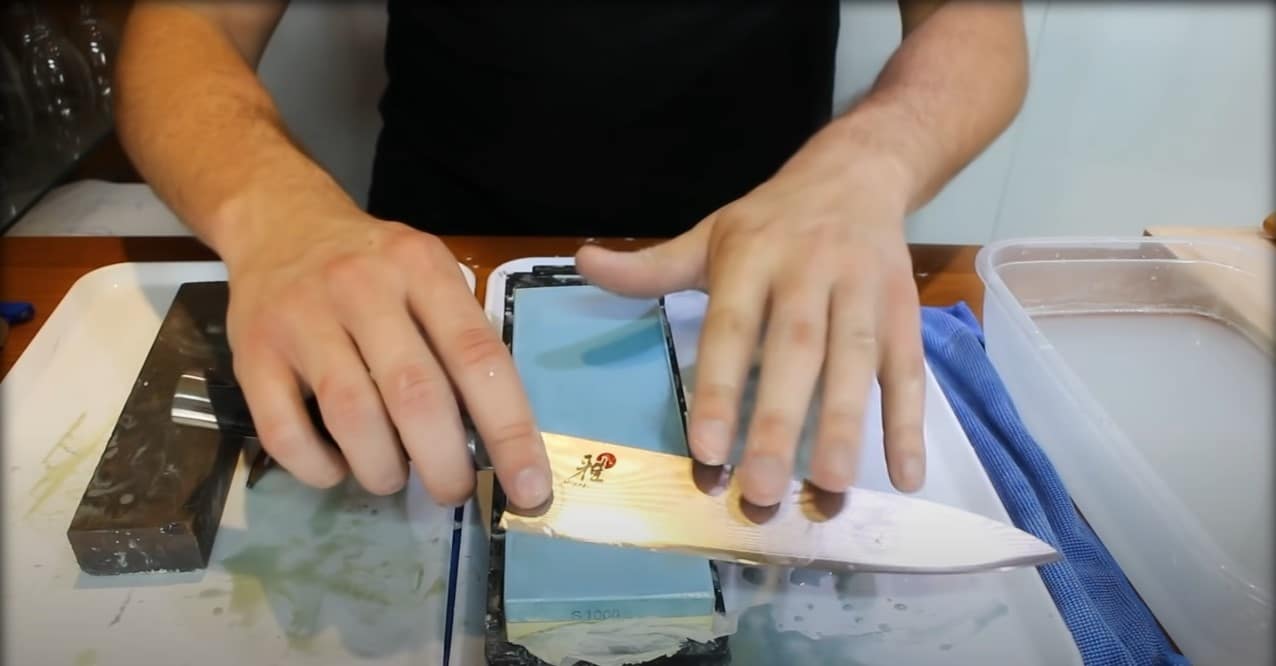
This process, however, will work with kitchen knives, pocket knives, survivor knives, multi-tool blades, bushmaster knives, etc. Of all of the knife cleaning and maintenance skills, knowing the ways to sharpen a knife is one of the hardest to learn, but it is also one of the most fulfilling and will forge a bond between you and your knife.
Make sure you take care of your stone and try not to drop it as this can cause it to break. Also, remember to put away your stone as well as all knives and other sharp tools, keeping them out of the reach of children to avoid injury or accidents.
Best Sharpening Stone Summary
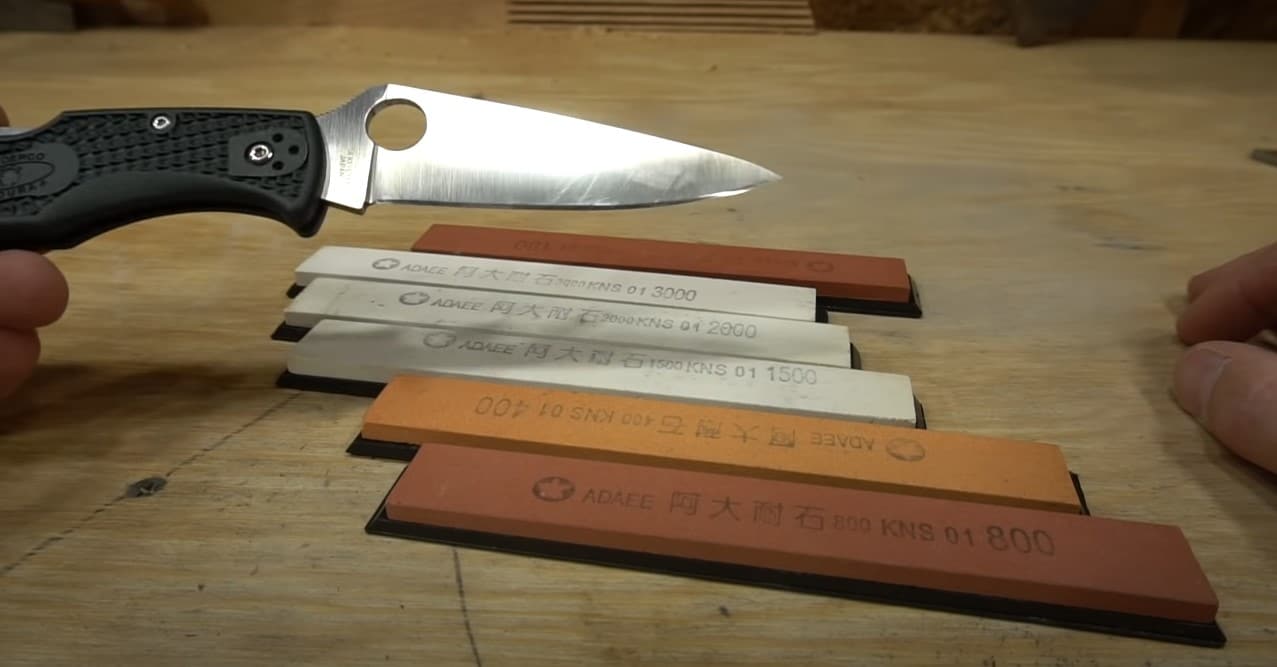
There are several types of such stones made of different materials. For instance, you can find a diamond stone or a highly-prized natural stone in the store with higher prices and some ceramic or aluminum oxide stones with a lower cost. All of them are good sharpening stone options and deserve your attention. Look through the list of the best sharpening stones above and choose one that matches your criteria.
Frequently Asked Questions – FAQ
Do you wet a sharpening stone?
You need to soak sharpening stone with water or oil depending on the material it is made of. For instance, diamond stones do not require to be soaked prior to application to work with them, while aluminum oxide stones require oil or water. If you use fine grit stone, five minutes of soaking it in the water will be enough. However, if your stone has coarser grit, spend ten minutes soaking it.
Is a sharpening stone better than a knife sharpener?
A knife sharpener is easier to use, and that is why it is more common among users. However, it can damage the edge of steel knives, and it will decrease their lifespan. That is why sharpening stone is the preferable option for knife enthusiasts, but be careful and choose fine stone or coarser one according to the prior state of your blades.
Should I use water or oil on my sharpening stone?
Before purchasing a sharpening stone, you should learn details about its coarseness and characteristics. There are types of stones that can create a sharp knife edge without water, but the cheapest options are synthetic water stones. It means that you should wet it before application and use water with a cleaning stone after the procedure.

